
Hovea is a genus of about forty species of flowering plants in the family Fabaceae, and is endemic to Australia. Plants in this genus are sub-shrubs, shrubs or small trees with simple leaves and purple, blue or mauve flowers with a white centre. The fruit is a pod containing brown to blackish seeds. Species of Hovea occur in all Australian states, the Australian Capital Territory and the Northern Territory.

Howittia is a genus of plant containing the single species, Howittia trilocularis, commonly known as blue howittia, and is endemic to Australia. It is a tall shrub found growing in shaded valleys and on rainforest edges, it has hairy leaves and single, purple flowers.

Hibiscus heterophyllus, commonly known as native rosella or toilet paper bush, is a flowering plant in the family Malvaceae. It a shrub or small tree with white, pale pink or yellow flowers with a dark red centre and grows in New South Wales and Queensland.

Aotus ericoides, also known as common aotus or golden pea, is a shrub in the family Fabaceae. It flowers in leaf axils in spring and has yellow pea flowers with splotches of red. It is endemic to eastern Australia.

Hakea sericea, commonly known as bushy needlewood or silky hakea, is a large shrub with a profusion of mainly white flowers from July for several months. It is endemic to eastern Australia. It has become an environmental weed in some countries.
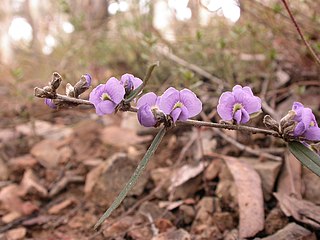
Hovea heterophylla, commonly known as creeping hovea, is a small shrub with linear leaves and purple-violet pea flowers. It is found in all states other than Western Australia.
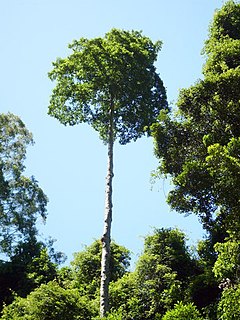
Elaeocarpus obovatus, commonly known as hard quandong, blueberry ash, whitewood, grey carabeen, freckled oliveberry or gray carrobeen, is a species of flowering plant in the family Elaeocarpaceae and is endemic to eastern Australia. It is a tree with buttress roots at the base of the trunk, egg-shaped to lance-shaped leaves with the narrower end towards the base, racemes of white flowers, and blue, oval fruit.

Hovea acanthoclada, commonly known as thorny hovea, is a flowering plant in the family Fabaceae. It is an upright, prickly shrub with small dark green leaves and purple-blue pea flowers in winter and spring. It is endemic to the south-west of Western Australia.
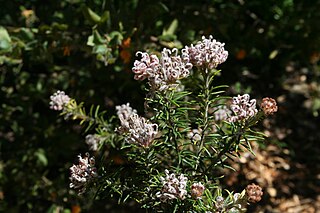
Grevillea acerata, is a plant in the family Proteaceae and which is endemic to New South Wales. It is a spreading shrub with more or less linear leaves and groups of woolly cream-coloured to grey flowers in groups on the ends of the branches. It is similar to Grevillea sphacelata and is only known from the Gibraltar Range National Park and nearby Glen Elgin.

Hovea lanceolata is a shrub in the pea family, native to Australia. It grows up to 2 metres tall and is found on rocky areas, sandy soils and ridges. Usually growing west of the Great Dividing Range in northern New South Wales and Queensland.

Persoonia mollis, commonly known as soft geebung, is a plant in the family Proteaceae and is endemic to New South Wales. It is an erect to prostrate shrub with linear to oblong or spatula-shaped leaves, yellow flowers in groups of up to thirty on a rachis up to 150 mm (5.9 in) long and relatively small fruit.
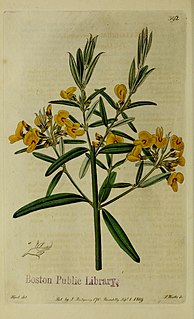
Oxylobium arborescens, commonly known as the tall shaggy-pea, is a species of flowering shrub to small tree in the family Fabaceae and is endemic to south-eastern Australia. It has elliptic dark green leaves and yellow pea flowers.

Grevillea raybrownii is a flowering shrub in the family Proteaceae and is endemic to New South Wales. It has divided, pointed leaves and dense clusters of flowers usually at the end of branches.
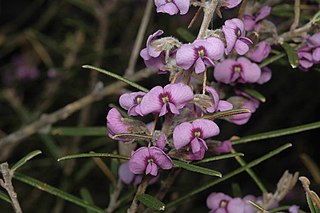
Hovea rosmarinifolia, commonly known as mountain beauty or rosemary hovea is a shrub in the family Fabaceae, native to Australia. A small shrub bearing attractive blue-purple or mauve pea flowers from August to November.
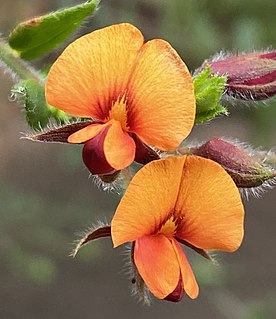
Oxylobium cordifolium, commonly known as the heart-leaved shaggy pea, is a species of flowering plant in the family Fabaceae and is endemic to New South Wales. It is a small, prostrate shrub with long, wiry branches, heart-shaped leaves and orange-red flowers.
Chloanthes glandulosa is a species of flowering plant in the family Lamiaceae. It is a small shrub with wrinkled leaves and greenish-yellow tubular flowers. It is endemic to New South Wales.
Cassinia accipitrum is a species of flowering plant in the family Asteraceae and is endemic to eastern New South Wales. It is an erect shrub with spreading, dark green leaves that are covered with cottony hair on the underside, and heads of yellowish brown flowers arranged in rounded cymes.
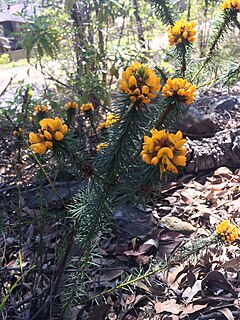
Pultenaea aristata, commonly known as bearded bush-pea or prickly bush-pea, is a species of flowering plant in the family Fabaceae and is endemic to New South Wales. It is a small, erect shrub with linear to narrow elliptic, sharp-tipped leaves, and yellow and red flowers.
Pultenaea benthamii, commonly known as Bentham's bush-pea, is a species of flowering plant in the family Fabaceae and is endemic to south-eastern continental Australia. It is an erect shrub with sharply-pointed, narrow elliptic to linear leaves and yellow to orange and red flowers in clusters at the ends of branches.

Pultenaea capitellata, commonly known as hard-head bush-pea, is a species of flowering plant in the family Fabaceae and is endemic to south-eastern continental Australia. It is a sprawling to prostrate shrub with elliptic to broadly egg-shaped leaves, and yellow to orange flowers with a red to purple keel.
















